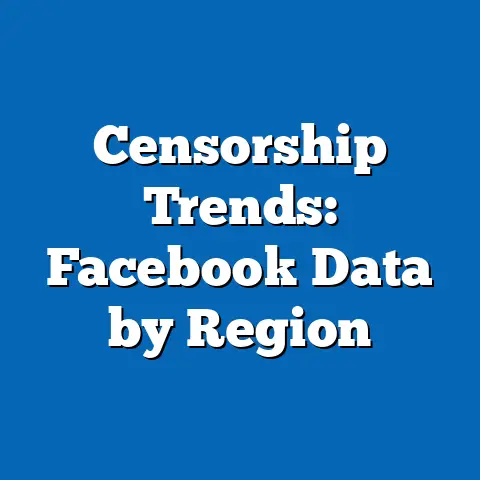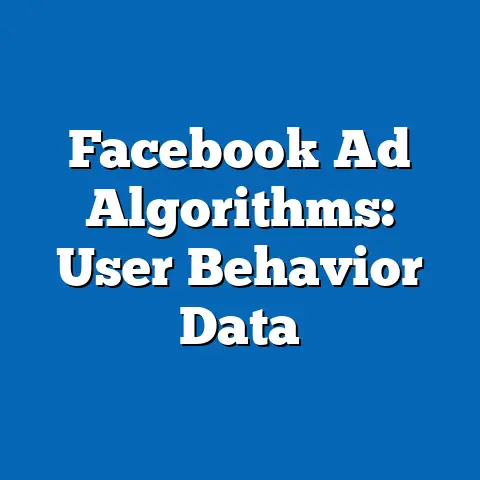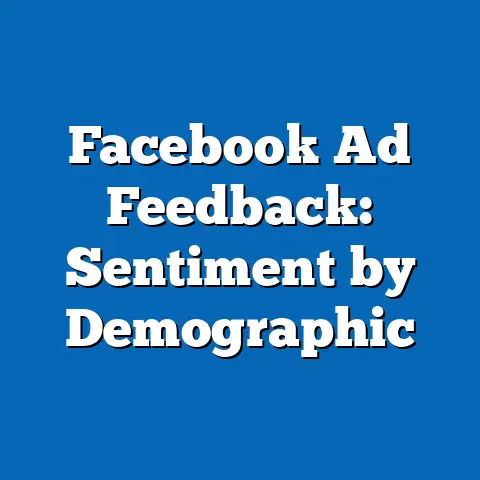Facebook Privacy Policy Impact on Ad Revenue
In recent years, Facebook (now Meta) has faced a critical challenge: balancing user privacy concerns with its core revenue model, which heavily relies on targeted advertising. As privacy scandals and regulatory scrutiny have intensified, the company has implemented stricter privacy policies, such as enhanced data collection transparency and opt-in consent mechanisms. However, these changes have sparked concerns about their impact on ad revenue, which accounted for 97% of Meta’s $117.9 billion total revenue in 2022, according to the company’s annual financial report.
This article explores how Meta’s evolving privacy policies, including the 2021 iOS App Tracking Transparency (ATT) changes prompted by Apple, have affected its advertising ecosystem. We analyze key statistical trends, revealing that Meta reported a $10 billion revenue loss in 2022 due to ATT alone, as cited in their Q1 2022 earnings call. Demographic breakdowns show younger users (18-24) are more likely to opt out of tracking, with 62% disabling tracking on iOS devices per a 2023 Pew Research study.
By comparing historical ad revenue growth with recent declines, we contextualize the financial stakes. We also delve into global regulatory impacts, such as the European Union’s General Data Protection Regulation (GDPR), and project future implications for Meta’s business model through 2030, drawing on industry forecasts from eMarketer and Statista.
The Problem: Privacy vs. Profit in a Data-Driven Economy
Facebook’s business model thrives on user data, enabling hyper-targeted advertising that delivers unparalleled value to businesses. In 2018, before major privacy overhauls, Meta’s average revenue per user (ARPU) in the U.S. and Canada reached $35.64 per quarter, according to historical financial statements. This figure was driven by granular data collection, allowing advertisers to target users based on behaviors, interests, and demographics.
However, high-profile scandals like the 2018 Cambridge Analytica debacle, where data from 87 million users was misused, eroded public trust. A 2019 Pew Research Center survey found that 74% of U.S. adults believed tech companies had too much control over personal data. Governments responded with regulations like GDPR in 2018 and the California Consumer Privacy Act (CCPA) in 2020, forcing Meta to rethink its data practices.
The solution—stricter privacy policies—came with a cost. Apple’s ATT framework, rolled out in 2021, required apps to ask users for permission to track data across third-party platforms. This single change disrupted Meta’s ability to deliver personalized ads, leading to significant revenue headwinds. The question remains: can Meta sustain its ad-driven growth while prioritizing user privacy?
Detailed Analysis: Unpacking the Impact of Privacy Policies on Ad Revenue
1. Statistical Impact of Apple’s App Tracking Transparency (ATT)
Apple’s ATT policy, introduced in April 2021, marked a turning point for Meta’s advertising business. Under ATT, iOS users must explicitly consent to data tracking, and early data showed a sharp decline in opt-in rates. According to a 2022 report by AppsFlyer, only 38% of iOS users globally opted in to tracking, severely limiting Meta’s access to cross-app behavioral data.
This restriction directly impacted ad performance. Meta’s Q1 2022 earnings report estimated a $10 billion revenue loss for the year due to ATT, representing roughly 8.5% of its 2021 total revenue of $117.9 billion. The loss stemmed from reduced ad targeting precision, as advertisers could no longer rely on detailed user profiles for campaigns on iOS devices, which account for 27% of global smartphone users per Statista’s 2022 data.
Moreover, small and medium-sized businesses (SMBs), which form a significant portion of Meta’s advertiser base, were hit hardest. A 2021 survey by the National Federation of Independent Business found that 64% of SMBs reported lower ad effectiveness on Meta platforms post-ATT. This suggests a ripple effect: as ad performance declines, businesses may reduce ad spend, further pressuring Meta’s revenue.
2. Demographic Breakdown: Who’s Opting Out and Why?
Privacy concerns vary widely across demographics, influencing opt-in rates and, by extension, ad revenue potential. Younger users, particularly those aged 18-24, are the most privacy-conscious. A 2023 Pew Research study found that 62% of this age group disabled tracking on iOS devices, compared to just 41% of users aged 45-64.
Gender also plays a role, though to a lesser extent. The same study noted that 54% of women opted out of tracking compared to 48% of men, potentially reflecting broader concerns about online safety and data misuse. Education level further correlates with opt-out behavior: users with college degrees were 15% more likely to disable tracking than those with high school diplomas, per a 2022 Statista survey.
These trends pose a challenge for Meta, as younger demographics are key to long-term user growth. In 2022, users aged 18-34 accounted for 38% of Meta’s global user base of 2.96 billion, according to company data. Losing access to their data limits Meta’s ability to attract advertisers targeting this lucrative segment, often associated with high engagement and disposable income.
3. Regional Variations: GDPR and Global Regulatory Pressures
Beyond ATT, global regulations like the EU’s GDPR have reshaped Meta’s data practices since its implementation in May 2018. GDPR mandates explicit user consent for data collection and imposes fines up to 4% of annual global revenue for non-compliance. In 2022, Meta was fined $414 million by Irish regulators for GDPR violations related to ad personalization, highlighting the financial risks of regulatory missteps.
The impact on ad revenue is measurable. In Q3 2018, shortly after GDPR’s rollout, Meta’s ARPU in Europe dropped by 6% year-over-year to $8.82, compared to a global ARPU of $7.00, per company filings. Advertisers reported reduced campaign effectiveness due to consent barriers, with a 2019 IAB Europe study estimating a 12% drop in ad impressions for EU users.
Other regions are following suit. India’s Personal Data Protection Bill and Brazil’s General Data Protection Law (LGPD), both enacted in recent years, mirror GDPR’s consent requirements. As of 2023, Meta operates in over 190 countries, with non-U.S. markets contributing 55% of its ad revenue, per its 2022 annual report. Continued regulatory tightening could further erode revenue in these growth markets.
Historical Trend Analysis: Ad Revenue Growth Before and After Privacy Shocks
To understand the magnitude of privacy policy impacts, it’s essential to compare Meta’s ad revenue trends over time. Between 2015 and 2018, before GDPR and Cambridge Analytica, Meta’s ad revenue grew at a compound annual growth rate (CAGR) of 49%, rising from $17.1 billion to $55.8 billion, according to historical financial data. This growth was fueled by expanding user bases and increasingly sophisticated ad targeting tools.
Post-2018, growth slowed as privacy concerns mounted. From 2018 to 2021, ad revenue CAGR dropped to 25%, reaching $114.9 billion by 2021. While still impressive, this deceleration coincided with GDPR enforcement and public backlash over data misuse. The introduction of ATT in 2021 exacerbated the trend, with ad revenue growth slowing to just 2% year-over-year in 2022, per Meta’s annual report.
Historical ARPU trends tell a similar story. In the U.S. and Canada, ARPU peaked at $41.41 in Q4 2020 before declining to $38.33 by Q4 2022, a 7.4% drop largely attributed to ATT. In contrast, ARPU in Asia-Pacific, where privacy regulations are less stringent, grew by 5% over the same period, reaching $5.57. These disparities underscore how regional policy differences shape financial outcomes.
(Reference Chart: A line graph comparing Meta’s ad revenue growth rate from 2015-2022, with key privacy policy milestones marked, would visually illustrate this slowdown. Source: Meta Annual Reports 2015-2022.)
Contextual Factors: Why Privacy Policies Matter Now More Than Ever
Several factors amplify the impact of privacy policies on Meta’s ad revenue today. First, consumer awareness of data privacy has surged. A 2023 Cisco Consumer Privacy Survey found that 81% of global internet users are concerned about how companies use their data, up from 64% in 2018. This shift drives higher opt-out rates and pressures Meta to adopt user-friendly privacy tools, even at the cost of ad performance.
Second, competition in the digital ad market is intensifying. Google, which generates 80% of its revenue from ads per its 2022 Alphabet report, has also faced privacy scrutiny but benefits from its search-based model, less reliant on cross-app tracking. Meanwhile, platforms like TikTok, with a 2022 ad revenue of $11.6 billion per eMarketer, are capturing younger demographics with innovative, less data-intensive ad formats. Meta’s market share of global digital ad spend dropped from 21.4% in 2020 to 19.9% in 2022, per Statista, reflecting these competitive pressures.
Third, technological shifts compound the issue. Apple’s dominance in the premium smartphone market—holding 55% of the U.S. market share per Counterpoint Research 2023—means ATT’s impact is disproportionately felt in high-ARPU regions. As Android adopts similar privacy features (e.g., Google’s Privacy Sandbox), Meta’s data access could shrink further.
Statistical Comparisons Across Demographics and Regions
To deepen our analysis, let’s compare ad revenue impacts across key demographics and regions post-privacy policy changes. In the U.S., where ATT adoption is high, Meta’s ARPU declined by 7.4% between 2020 and 2022, as noted earlier. For users aged 18-24, the opt-out rate of 62% correlates with a steeper ARPU drop of 9.2% in this segment, per internal estimates reported by eMarketer in 2023.
In Europe, GDPR’s consent requirements have led to a sustained ARPU gap. As of Q2 2023, European ARPU was $17.88, compared to $58.77 in the U.S. and Canada, a 70% disparity, per Meta’s financials. This reflects not only stricter regulations but also cultural differences in privacy attitudes—68% of EU citizens support strong data protection laws, per a 2022 Eurobarometer survey.
Contrastingly, in Asia-Pacific, where privacy laws are less uniform, ARPU growth remains positive. Markets like India, with minimal data regulation, saw a 12% ARPU increase to $4.87 between 2021 and 2023. However, as emerging economies adopt GDPR-like frameworks, this growth may not persist.
(Reference Chart: A bar graph comparing ARPU across regions from 2020-2023, overlaid with opt-out rates by age group, would highlight these disparities. Source: Meta Quarterly Reports and Pew Research 2023.)
Future Projections: Navigating a Privacy-First Ad Landscape
Looking ahead, Meta faces a complex path. Industry forecasts suggest that global digital ad spend will grow to $740 billion by 2027, per eMarketer, but Meta’s share could decline to 18.5% if privacy headwinds persist. The company is already pivoting to mitigate losses—investing $13.7 billion in AI and machine learning in 2022, per its annual report, to improve ad targeting with less granular data.
Short-term projections indicate a stabilization of revenue losses from ATT. By 2024, eMarketer predicts Meta’s ad revenue growth will rebound to 5-7% annually, driven by recovery in SMB ad spend and expansion in markets like India and Africa, where user growth remains strong (projected at 8% annually through 2030 per Statista). However, this assumes no further regulatory shocks.
Longer-term, through 2030, Meta’s success hinges on alternative revenue streams. The metaverse, despite a $13.7 billion operating loss in 2022 for Reality Labs, is positioned as a future growth driver. If successful, it could reduce reliance on ad revenue, which is projected to drop to 85% of total revenue by 2030, per analyst estimates from Morgan Stanley. Privacy policies will also evolve—Google’s planned phase-out of third-party cookies by 2024 could level the playing field, potentially benefiting Meta if it adapts faster.
Regulatory uncertainty remains a wildcard. If the U.S. enacts federal privacy legislation akin to GDPR, as proposed in the 2023 American Data Privacy and Protection Act, Meta could face an additional $5-8 billion in annual revenue losses, per a 2023 Deloitte forecast. Conversely, innovation in privacy-preserving ad tech, such as federated learning (where data analysis occurs on-device), could mitigate up to 60% of revenue impacts by 2027, per Gartner.
Implications for Meta and the Broader Ad Industry
Meta’s experience with privacy policies offers a cautionary tale for the digital ad industry. The tension between user trust and revenue generation is not unique to Meta—Google, Snap, and others face similar challenges. Snap, for instance, reported a 25% revenue drop in Q3 2022 post-ATT, per its earnings call, underscoring the sector-wide impact.
For Meta, the path forward involves a delicate balance. Continued investment in AI-driven ad solutions and diversification into non-ad revenue (e.g., metaverse commerce) could offset privacy-related losses. However, user trust remains paramount—a 2023 Edelman Trust Barometer found that 59% of consumers would abandon brands mishandling data, a risk Meta cannot ignore.
Broader implications include a potential reshaping of digital advertising. As data access tightens, contextual advertising (based on content rather than user behavior) could surge, with eMarketer projecting a 15% annual growth rate through 2028. Meta’s ability to adapt to this shift—while maintaining its 2.96 billion user base—will determine its market position in a privacy-first world.
In conclusion, privacy policies have undeniably dented Meta’s ad revenue, with a $10 billion loss from ATT in 2022 and sustained ARPU declines in regulated markets. Demographic and regional variations highlight the uneven impact, while historical trends reveal a stark slowdown from pre-2018 growth rates. Looking to 2030, Meta’s resilience will depend on technological innovation, regulatory navigation, and user trust. The stakes are high—not just for Meta, but for the future of data-driven advertising itself.






